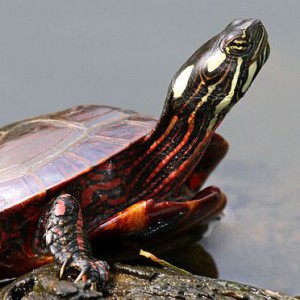![]() There is something amazingly captivating about turtles: those slow, long-living, hard-shelled creatures, which look very much like how you’d expect a miniature version of some dinosaur to look. They have inspired artists for many years, and continue to do so, from the Mock Turtle in Lewis Caroll’s Alice’s Adventures in Wonderland, through the impressive, world-carrying Great A’Tuin in Terry Pratchett novels, to the symbols of late 20th century pop-culture that are the Teenage Mutant Ninja Turtles. Turtles are enigmatic and elegant, reason enough for their study; with many turtle species on the brink of extinction, however, the need to capture the full scope of their biology becomes more urgent. It is perhaps surprising, therefore, that turtles are the largest group of tetrapods for which no genome sequence has been published. Until now, that is.
There is something amazingly captivating about turtles: those slow, long-living, hard-shelled creatures, which look very much like how you’d expect a miniature version of some dinosaur to look. They have inspired artists for many years, and continue to do so, from the Mock Turtle in Lewis Caroll’s Alice’s Adventures in Wonderland, through the impressive, world-carrying Great A’Tuin in Terry Pratchett novels, to the symbols of late 20th century pop-culture that are the Teenage Mutant Ninja Turtles. Turtles are enigmatic and elegant, reason enough for their study; with many turtle species on the brink of extinction, however, the need to capture the full scope of their biology becomes more urgent. It is perhaps surprising, therefore, that turtles are the largest group of tetrapods for which no genome sequence has been published. Until now, that is.

In an article published today in Genome Biology, an international consortium (led by Bradley Shaffer of UCLA) describes the draft genome sequence of Chrysemys picta bellii, popularly known as the western painted turtle. A phylogenetic analysis of this species places it as a sister group to the living archosaurs (crocodilians and birds). Interestingly, the relative evolutionary rates for this turtle are incredibly slow, a finding that might at least partially be related to the longevity of individuals within the species.
The article also takes a closer look at the turtle’s adaptation to low temperatures and to hypoxia: the species is known to be able to withstand low oxygen levels and temperatures as cold as 3°C for many days, if not months. A number of genes are pinpointed as having altered activity, in some cases quite substantially, when the oxygen level drops. A point mutation in the microRNA miR-29b form is shown to be a potential component of the mechanism by which turtles have adapted to withstand low temperatures: the mutation alters the flexibility of the microRNA’s loop, which results in miR-29b increased abundance in turtle hatchlings exposed to freezing conditions for 24 hours. How miR-29b might confer this protection through gene regulation will be an interesting question for future studies to address.
With these turtles evolving as slowly as they live, it might still be a while before we see any mutant turtles, ninja or not-ninja. You shouldn’t feel too disappointed though: the genome of the western painted turtle clearly shows that, even without the benefit of martial arts expertise acquired through mutagenic radiation exposure, turtles remain remarkable creatures.
Comments